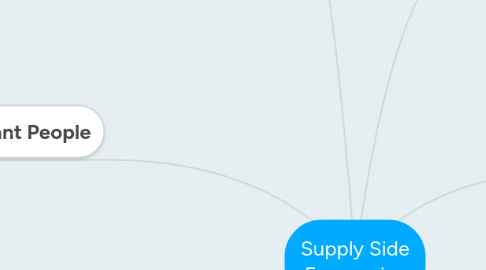
1. Important People
1.1. Ronald Reagan
1.1.1. American
1.1.2. Promised to "balance the budget"
1.1.3. Elected in a time of great national deficit
1.1.4. "Reaganomics"
1.1.4.1. Another way of saying supply side
1.1.5. Introduced massive tax cuts
1.2. Margaret Thatcher
1.2.1. British
1.2.2. "Thatcherism"
1.2.2.1. Another way of saying supply side
1.2.3. Good friends with Reagan, worked together to change policies both in America and in Britain
1.3. Milton Friedman
1.3.1. Argues against Keynesian economics
1.3.1.1. Says they increase interest rates
1.3.1.2. Says they lead to lower investment by private enterprise
1.3.2. Believes that to deal with inflation, government should expand/contract supply of money
2. Monetary Policies
3. Dealing With Unemployment
3.1. No government involvement
3.2. Reduced income tax
3.2.1. Allows people to save, have savings to fall back on during recession and times of unemployment
3.2.2. Leads to more company profits, more production, more jobs
3.2.2.1. Exponential increase, these increased jobs increase demand and create even more jobs
4. Fast Economy (recovery)
4.1. Increase interest rates
4.1.1. Reduces amount of money available
4.1.2. Reduces borrowing and spending
4.1.3. Slows down or stops inflation
5. Reduce taxes both corporate and personal
5.1. High taxes reduce incentive to work, save and invest
5.2. Reducing corporate taxes produces profit and entices more people to enter business, speeding up economy
5.2.1. Increased profits means more production, and more employment
5.2.2. More production means more demand, demand must come from private enterprises instead of government spending
5.3. Reducing personal taxes increases incentive to work, invest, and save
6. Dealing With Recession
6.1. Very low government intervention
6.2. Emphasis on producer over consumer
6.2.1. When producers are successful, their production makes it's own demand
7. Dealing With Inflation
7.1. Cut taxes
7.1.1. Incentive to work hard and save money
7.2. No increase in government spending
7.2.1. Government spending jeopardizes free market, free market can control itself
7.3. Free market will control itself eventually, economic cycle
7.3.1. Inflation will get to its peak and lead into a recession
8. Slow Economy (recession)
8.1. Lower interest rates
8.1.1. Increases amount of available money
8.1.2. Increases profits, demand, and employment rates
8.1.3. Sppeds up the economy, leads it out of recession

